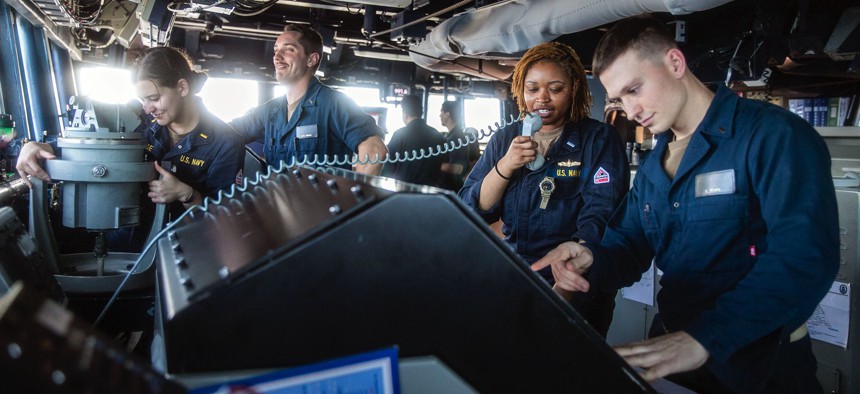The Navy is building dashboards for its connect-everything effort

Sailors stand watch on the bridge aboard the Arleigh Burke-class guided-missile destroyer USS Sterett (DDG 104) during routine operations in the South China Sea on Dec. 14, 2023. U.S. Navy / Petty Officer 1st Class Charles J Scudella
A conversation with Rebellion Defense about its new contract for Project Overmatch.
As the U.S. Navy works to link its IT systems, it has hired a software company to create tools to keep sailors from drowning in data.
“There's so much that goes into JADC2 at different levels of detail and different data flows,” said Rebellion Defense CEO Ben FitzGerald. “And we're very interested in how we can help the humans in those systems understand if they're being effective. So we're sort of sitting on top of a bunch of other important work to establish efficacy in these matters.”
Rebellion Defense just landed its first contract for Project Overmatch, the Navy’s largely secretive part of the Pentagon’s JADC2—that is, combined joint all-domain command and control—effort. Defense One spoke with FitzGerald about the company’s work on the hush-hush project:
D1: This contract sounds like it’s for a user interface. What is it and why is it important?
FitzGerald: I'm gonna have to do the thing that happens with all Overmatch things, which is [say] a lot of it's classified.
We're very excited to be part of it, especially because it's early in the pace. And there's a lot of important work being done on what is most valuable for sailors in terms of how to achieve decision advantage. And that's really at the heart of what we're focused on.
D1: How do the Navy’s unique challenges, such as being largely disconnected from land-based networks, shape your work?
FitzGerald: The things that we’re focused on is technology that allows humans to describe what's working for them and not. There's a lot of stuff that has to happen, like systems-to-systems and data integration. And where we're focused is where information systems hit humans and what that means.
Ultimately, it's things that help the Navy, and particularly sailors, understand how to use their technology to achieve decision advantage.
D1: This is a small contract—about $223,000—for six months of work and no future promises. Does this approach work for software companies?
FitzGerald: We really appreciate the way that the Overmatch team is thinking about this: bringing in organizations like ours with small amounts of work to start and ensure that we've got good things that can lead to other things. As opposed to a massive multi-year requirements process…and then a big bang at the end. This gives us an opportunity to sort of get in, hopefully show some value….and then grow from there.
User feedback and the ability to iterate rapidly is at the heart of how any commercial tech company scales. Being able to get access to real problems and real users without a huge amount of time, or red tape getting in the way, is just incredibly valuable.
[Our engineers] are able to talk about specific things. It's super motivating for our team to be that involved in something meaningful. And those are all like atmospheric things. But that's very helpful. It helps us to align our product vision with the reality of what the users need, and meet them where they are.
Building scalable software is hard. Running startups is hard. Working with the Department of Defense is also hard.
And so just being able to approach this with the humility of what does the customer need, and how do we meet them where they are, is really helpful. So, if we need to collaborate with other partners…if we need to think about are we delivering this as a [software-as-a-service] solution or a like as an edge solution, we want to be very thoughtful in how we do that.
D1: How soon will you get to a minimally viable product?
FitzGerald: We have specific deliverables that we've signed up to that we are actually slightly ahead of schedule on delivering. Beyond that, as a former acquisition professional myself, I cannot give a sense of the government's intention. But we have every intention of continuing to support the Navy on all of these matters.
D1: Rebellion also landed an Air Force contract for around $750,000 to use your automated cyber tool Nova with Cloud One, the service’s enterprise cloud platform. What’s special about this contract?
FitzGerald: [It’s an opportunity] to think about the role of automated red-teaming in securing the DOD's entire information assets—so not just the network, but applications as well.
As we think about Cloud One, initiatives that help the departments deploy and scale software more quickly and securely are just critically important.
We just got a provisional authority to operate through [the Defense Information Systems Agency] at IL 5...which took us about two years. And DISA is only able to certify a very small number of companies each year. And so there's a huge bottleneck there, which is a challenge.
There's only a handful of companies that have those.
With things like Cloud One, if we're able to contribute to an environment that makes it easier to get secure software onto networks, so that we don't have to [spend years getting authorities] that's good for us, obviously, but it's also good for the community.
This interview has been edited and condensed for length and clarity.



